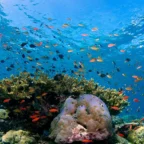
Lutjanidae
The snappers are a large and diverse group of robust-bodied, carnivorous fishes. Most species possess relatively large mouths with stout canine teeth and bodies covered with relatively large, coarse scales. They are frequently brightly coloured. They are demersal (spending most time swimming close to the sea bed) in some cases down to 450m and are found in the tropical and sub tropical waters of the Atlantic, Indian and Pacific Oceans. There are over one hundred individual species globally, but within the North Atlantic Coast Sub-tropical eco region there are only a limited number of species that you are likely to see at diving depth,
The cubera snapper (Lutjanus cyanopterus) is the largest member of the snapper family and the only one on our list that is on the IUCN Red List. It is cited as vulnerable.
Cubera have large, stocky bodies that vary in color from grey to dark brown. The body often appears to have a reddish sheen. Some specimens have pale spots on the upper body, which are especially prevalent in the young. They are usually darker above the lateral line with their color fading below.
The cubera has two dorsal fins and small pectoral fins. The dorsal and pectoral fins have a metallic grey colour, while the pectoral fins can appear translucent. The reddish coloured anal fin is rounded. All of the fins can occasionally have a blue tinge.
Cubera snapper have large mouths with thick lips and a projecting lower jaw. Both jaws are very powerful. The teeth are in a triangle shape at the top of the mouth. The canines are large enough that they are visible even when the mouth is closed. The dark red eyes of the cubera appear large in relation to the size of the head.
A solitary, cautious fish, not easily approached underwater, adults are found mainly around ledges over rocky bottoms or around reefs. Cubera snapper are known as aggressive carnivores, feeding mainly on mediumsized fish and crabs. Their large, strong canine teeth also allow more mature fish to eat larger crustaceans such as lobster. They typically feed near the bottom in rocky areas near reefs or other underwater structures.
Other species that you might encounter whilst diving in the region are shown below. The approximate maximum adult size is also included in the list:
- Ambiguous Snapper Lutjanus ambiguus 40 cm
- Black Snapper Apsilus dentatus 65 cm
- Blackfin Snapper Lutjanus buccanella 75 cm
- Grey Snapper Lutjanus griseus 89 cm
- Lane Snapper Lutjanus synagris 60 cm
- Mahogany Snapper Lutjanus mahogoni 48 cm
- Mutton Snapper Lutjanus analis 94 cm
- Queen Snapper Etelis oculatus 100 cm
- Schoolmaster Snapper Lutjanus apodus 65 cm
- Silk Snapper Lutjanus vivanus 83 cm
- Slender Wenchman Pristipomoides freemani 23 cm
- Southern Red Snapper Lutjanus campechanus 100 cm
- Vermillion Snapper Rhomboplites aurorubens
- Wenchman Pristipomoides aquilonaris 56 cm
- Yellowtail Snapper Ocyurus chrysurus 85 cm









Social Profiles